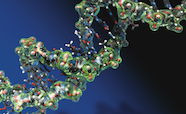Monday 22 January 2018 10:53am
Dr Anuruddha Chatterjee has received a Marsden Fast Start Grant to explore a potential opposing ability of DNA methylation, traditionally considered a gene-silencing mechanism. He will explore its potential for gene activation.
His project is titled: Challenging the gene silencing dogma: DNA methylation as a mechanism for gene activation. He describes his projectas follows:
DNA methylation widely regarded as gene-silencing mechanism
DNA methylation provides a stable mechanism for modulating the gene expression program of a cell. Promoter methylation is associated with chromatin condensation and suppression of gene expression; thus, methylation is widely regarded as a gene-silencing mechanism.
High gene expression found to coincide with methylation
Strikingly, contrary to this dogma, we have identified several instances where densely-methylated promoters coincide with high gene expression. If found to be causal, this observation could overturn tightly held views about the function of DNA methylation.
Research methodology to establish causation
We will use state-of-the-art epigenomic tools and a well-characterised melanoma model to connect methylation with chromatin biology and 3D genome organisation to establish causation for DNA methylation-mediated gene activation in the mammalian genome.
Dr Aniruddha Chatterjee says "We will be using flow cytometry facilities in our approach to isolate the cells that shows evidence of targeted DNA methylation editing, which will be very exciting”.

Flow cytometry contacts
For initial advice and consultation:
- Email michelle.wilson@otago.ac.nz (North campus)
- Email katie.young@otago.ac.nz (South campus)
More about flow cytometry services
What is flow cytometry?
Flow cytometry is used to analyse the physical and chemical characteristics of particles or cells carried in a fluid stream as they pass through at least one laser. Fluorescently-labelled cell components are excited by the laser to emit light at varying wavelengths, the emitted light is measured by detectors.